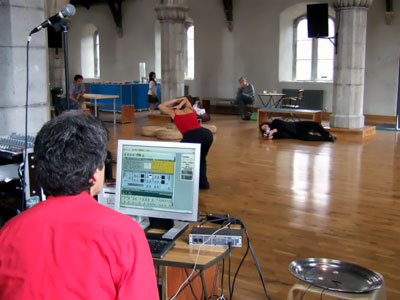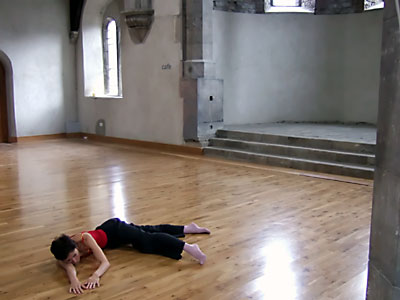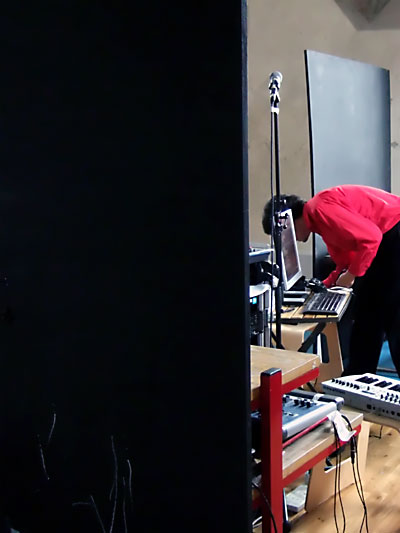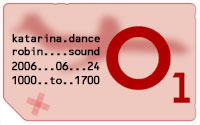
You don't know until you try to make music for seven hours whether such a task is even possible. In the weeks leading up to O1 I started assembling materials from the concepts that Katarina Mojzisova had discussed with me. Much of the piece revolved around definitions of the miniature, so I started my process there.
miniature: descriptive term for a short Romantic piece, usually for piano
This definition led me to select piano as my first raw material. I found stereo samples of a Steinway & Sons 3145A recorded with a stereo pair of Neumann KM 84 microphones. This is part of the collection of instruments made available by the University of Iowa Electronic Music Studios. These required a great deal of post-processing before they were usable. To a lesser degree I used samples of short pieces played by Glenn Gould.

miniature: derived from the Latin "minium", red lead. A picture in an ancient or medieval manuscript
From this definition came the second sound source: paper. I cut, crumpled, and otherwise manipulated various items of paper and sampled these into the computer.
Katarina had asked for rhythmic material, since such is necessary for her to sustain dancing over such a long period. Using various processing techniques, I manipulated the paper samples into a drum kit that I could then play back in various ways.

miniature: copy that reproduces something in greatly reduced size
miniature: a work of art where they represented object is created on a much-reduced scale
Granular synthesis works by cutting up a stream of sound into small particles time-wise, and then assembling them again with altered pitch, duration, envelope, amplitude, and so on. The greatly reduced size of the components engenders rich sonic results.
I decided to concentrate on that method of sound manipulation and ignore additive, subtractive, or other synthesis possibilities.

Finally, I wanted an interactive element. I taped two contact microphones to a metal tray, and made this "instrument" playable with some pennies and other small coins.
Piano / Paper / Pennies: that has a nice symmetry to it.
I then spent a couple of weeks assembling instruments in Reaktor, and coming up with a mixer setup that would allow channeling of any of the sources through such instruments for processing.
The performance itself went well. People dropped in throughout the day; some stayed for short periods but others were captivated and stayed for hours. A few people took Katarina's place and gave her a break from dancing. This was part of her original conception: that she could only stop dancing if someone else would fill in. Places of exhaustion she marked with red tape on the floor.
Some visitors were delighted to play around with the tray/penny instrument. Between the organically evolving sounds and shared dance a certain happy collaborative environment was created.
In this instance a seven-hour performance that at first looked only "possible" was made "probable" and then, finally, became inevitable.
I must first of all thank Katarina for inviting me to take part; Susannah for the photos and dancing; Róisín for the video, dancing, and play; Davide and the Daghdha Dance Company for the opportunity. Finally thank you to everyone who attended and participated.
See also my announcement with poster.
This definition led me to select piano as my first raw material. I found stereo samples of a Steinway & Sons 3145A recorded with a stereo pair of Neumann KM 84 microphones. This is part of the collection of instruments made available by the University of Iowa Electronic Music Studios. These required a great deal of post-processing before they were usable. To a lesser degree I used samples of short pieces played by Glenn Gould.

miniature: derived from the Latin "minium", red lead. A picture in an ancient or medieval manuscript
From this definition came the second sound source: paper. I cut, crumpled, and otherwise manipulated various items of paper and sampled these into the computer.
Katarina had asked for rhythmic material, since such is necessary for her to sustain dancing over such a long period. Using various processing techniques, I manipulated the paper samples into a drum kit that I could then play back in various ways.

miniature: copy that reproduces something in greatly reduced size
miniature: a work of art where they represented object is created on a much-reduced scale
Granular synthesis works by cutting up a stream of sound into small particles time-wise, and then assembling them again with altered pitch, duration, envelope, amplitude, and so on. The greatly reduced size of the components engenders rich sonic results.
I decided to concentrate on that method of sound manipulation and ignore additive, subtractive, or other synthesis possibilities.

Finally, I wanted an interactive element. I taped two contact microphones to a metal tray, and made this "instrument" playable with some pennies and other small coins.
Piano / Paper / Pennies: that has a nice symmetry to it.
I then spent a couple of weeks assembling instruments in Reaktor, and coming up with a mixer setup that would allow channeling of any of the sources through such instruments for processing.
The performance itself went well. People dropped in throughout the day; some stayed for short periods but others were captivated and stayed for hours. A few people took Katarina's place and gave her a break from dancing. This was part of her original conception: that she could only stop dancing if someone else would fill in. Places of exhaustion she marked with red tape on the floor.
Some visitors were delighted to play around with the tray/penny instrument. Between the organically evolving sounds and shared dance a certain happy collaborative environment was created.
In this instance a seven-hour performance that at first looked only "possible" was made "probable" and then, finally, became inevitable.
I must first of all thank Katarina for inviting me to take part; Susannah for the photos and dancing; Róisín for the video, dancing, and play; Davide and the Daghdha Dance Company for the opportunity. Finally thank you to everyone who attended and participated.
See also my announcement with poster.

